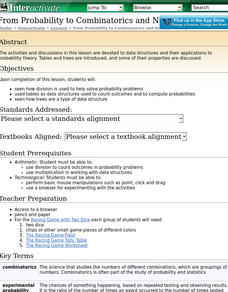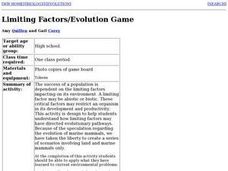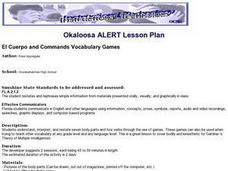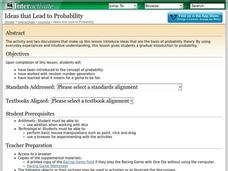Curated OER
Game Theory
Students examine the history of the game theory. They practice using new vocabulary. They write about the debate on exchange using different viewpoints.
National Council of Teachers of Mathematics
The Game of SKUNK
Do I stand or do I sit? The class plays a dice game where they must decide to either continue to stand and play or sit down and keep their points. After the game, groups discuss individuals' strategies and see connections to the...
Curated OER
Even/Odds Game
Using a game format, learners review what they know about theoretical probability. As they roll tetrahedron dice, they record their results as odd or even. Afterwards, they discuss their findings.
Curated OER
Probability & Game Theory
Students explore the concept of probability. In this probability lesson, students perform various probability experiments including flipping a coin, picking m&m's out of a bag, and the birthday problem.
Curated OER
Acting Like a Hog
Students explore game theory. In this secondary mathematics lesson, students plat the game of HOG using dice and explore the optimal strategies. Students play the game three ways: any number of dice, a fixed number of...
Curated OER
Acting Like a Hog
Students explore game theory. In this secondary mathematics lesson, students investigate the playing of a game called Hog which involves rolling dice. Students explore many different scenarios as they consider the best...
Shodor Education Foundation
From Probability to Combinatorics and Number Theory
What middle schooler does not enjoy an occasional online game? In this lesson play, you will find embedded links to an online probability game, and informative pages about how division is used in probability, the concept of tree models,...
Curated OER
More Games on Graphs
Students investigate various games employing graphs as game boards. In this game theory lesson, students problem solve through the use of graphs. The lesson is a list of both indoor and outdoor games to...
Digital Dream Lab's Art Game Swatch Out!
Why did we create an art game? Teachers reported to us that students struggle in art the most with composition of colors. For example, students often think "pink" is composed of random colors or that pink is its own color, instead of...
Curated OER
Unit 3 Cell Structures: Cell Theory & Organelles
Students examine cell structures in depth. They decide what grade they want to work for and do the assignments for that grade. They complete various assignments on cell theory and organelles.
Curated OER
Using Team Games Tournaments
Students review the unit on evolution and natural selection by playing a card game. Students take turns drawing a card from the stack and reading the question out aloud. The reader gives an answer. The other students, in turn may pass or...
Cornell Lab of Ornithology
Jump, Glide, or Fly? Exploring Bird Evolution
How have birds evolved from prehistoric animals? With the three-part lesson, small groups first research different prehistoric animals and determine whether they are birds. Then, scholars explore different bird adaptations using the Flap...
Curated OER
Hierarchy Theory and Biotic Hierarchy
Students examine the hierarchy theory and biotic organization by playing a teacher-created card game matching groups of items, such as organelles, in suits of four. They discuss the reasons for their hierarchical organization of the...
Curated OER
Limiting Factors/Evolution Game
High schoolers play a board game with provided cards which help them realize that limiting factors may restrict an organism in its development and productivity and direct evolutionary pathways.
Curated OER
Human Origins: The Prehistoric Human Race
When it comes to the origin of the human species young scholars are full of misconceptions. Clear up the hominid confusion with this evolutionary activity focused on assisting students in understanding prehistoric man and his family...
Curated OER
Factor Game (Number Theory)
Middle schoolers use a Factor Board game to identify the properties of prime, composite, abundant, deficient and perfect numbers. The game is comprised of the numbers from 1 to 30 placed in a 5 by 6 grid. Pupils figure out they can score...
Curated OER
Seeing Is Believing
Students investigate the concepts of probability. They use data to find the central tendency, median, and mode. Students design and play a game in order to practice the concepts. They also complete a table with data that is analyzed.
Curated OER
The Characteristics of Living Things
Eighth graders explore the characteristics of living things. In this living things lesson plan, 8th graders review as a class the cell theory and the characteristics of living things. They answer questions about how to determine if...
Curated OER
Understanding Cells
Learners identify and define several related vocabulary terms. Students complete a short lab and complete the questions. Learners create a cell crossword puzzle and play cell computer games through the included links.
Curated OER
El Cuerpo and Commands Vocabulary Games
Young scholars study Spanish vocabulary words for body parts, and also study a number of action verbs. They participate in Total Physical Response by responding to teacher given commands. They play a number of games based on the vocabulary.
Curated OER
Music Theory - Intervals
High schoolers explore types of intervals containing major and minor sixths. While using Auralia computer software, they participate in a game to identify sharp and flat pitches. Afterwards, they identify the pitches by ear and listen to...
Curated OER
From Probability to Combinatorics and Number Theory
Learners see how division is used to help solve probability problems. They use tables as data structures where they are used to count outcomes and to compute probabilities. Students use games to help solve probability problems.
Curated OER
Ideas that Lead to Probability
Students explore the concept of probability. In this probability lesson, students use random number generators to determine probabilities of events. Students discuss if certain probable events are fair. Students determine fair ways to...
Curated OER
Chances Are
Upper graders examine the concept of probability. They collect data and create a bar graph. They must interpret the data as well. Everyone engages in hands-on games and activities which lead them to predict possible outcomes for a...























